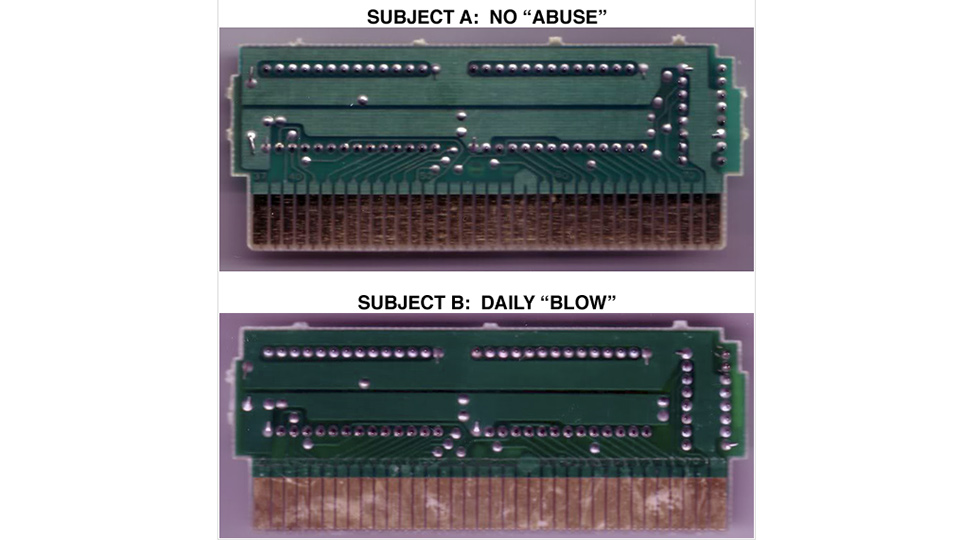When playing regular Nintendo, Super Nintendo, or even N64, there’s a good chance that you’ve had a game freeze. Many of us took the game out in response to the game freezing, blew in it as aggressively, and put it back in. Oddly enough, the game would work normally.
Blowing or spitting in the Nintendo cartridges does nothing to help the game work. More than likely, it collected dust and blowing into the cartridge, removed that dust so the game can get a clear read of the cartridge.
Another reason is for psychological reasoning called “conditioning.” When our brain starts to see a pattern of how something will work, it will continue to pursue that effort, tricking ourselves of that’s why it worked.
In this article, we’re going to show you why it did work and what the myth is about blowing into Nintendo cartridges.
Blowing Into The Nintendo Cartridge
Since Nintendo was released, there were known mechanical flaws in the reading of the games, which caused games to be fuzzy or distorted.
Players began blowing left to the right into the open part of the game, which would “magically” make the game work. This caused a game-blowing epidemic to make old games work like new.
The technique was simple; often, a quick up and down below would do the trick. Other times players would go back and forth a half dozen times to ensure the game was fully blown.
The player’s science behind blowing into the Nintendo Cartridges was often that the wetness from the spit would spark the electrical pins in the game. Also, as mentioned in the answer above, blowing dust out of the game (which it can in some cases) can be a reason for the excessive blowing.
However, according to this video from PBS, blowing into the cartridges is strictly a placebo effect. It’s our brains playing a trick on us.
The Science
The Nintendo warning is pretty clear about blowing or moisturizing into the open game port and system, stating:
“Do Not blow inyour your Game Paks or systems. The moisture in your breath can corrode and contaminate the pin connectors”
Just as we thought we were adding a short jolt to the connectors, we were actually doing long-term harm to the game. This is primarily why, over time, if you looked inside the game cartridge, it was often a brown disdained color with white is worn out spots.
Here is a great picture from kotaku.com to show exactly what we mean by disdained color.

As you may think, it does have a temporary solution of blowing heavily into the plastic; it was actually doing more long-term harm. Especially with constant day-to-day blowing and spitting into the port, it’s only a matter of time before the connectors wore out.
Our advice would be to wipe down the inside of the game with a cotton swab before actually doing any fluid magic. It may be just clogged up with some dust.
This trick will also prevent any wear and tear from the inside of the cartridge. It will also help save the game reader inside, as they will be staying dry as well.
See Our Complete List Of Helpful Gaming Articles Here.
Why Does Blowing Into Nintendo Cartridges Work?
According to reports, this was all just a trick our brain was playing on us. Randomly inserting the cartridges without blowing into them would have the same effect as if you did blow into them.
The reason it would work was based upon the number of times you loaded and unloaded the game, not necessarily how many times you blew it in. We tricked ourselves into believing it was the saliva or air coming from our mouths, not just the technical failures of how many times we loaded it in. This seems to be the issue as the success rate is measured.
The debate will continue as players firmly believe that blowing in it does work in some way.
Here’s visual proof of Youtuber AndrewsGamesDisplay doing a live test of it actually working.
Will I continue to blow into my cartridges until they work? Most likely. There’s no better feeling than getting a game to work after trying to take out and insert the game 20 times, only to blow in it, and it works immediately.
However, you don’t need to blow into the Nintendo cartridge, and the saliva that you’re blowing into the cartridge will do more harm to the game than good. The game will ultimately have its reading sensors on the inside of the cartridge stripped if you’re consistently blowing into it.
What Happens To The Nintendo Cartridge If I Keep Blowing Into It?
Try inserting and reinserting the game several times before you blow in the cartridge. It could be dust that needs to be shaken loose. If the problem persists, a small blow across the game might prove to be useful.
However, it’s unnecessary to continue to blow in the Nintendo cartridge as you’re doing more hard to the reader inside than actually helping the game. We love our Nintendo games and want them to last, help them last by not blowing spit, and other moisture into the game reader.
Anytime liquid is applied to anything electrical, there’s a chance it may not work. Especially if you put it in, take it out, and keep blowing on it. The amount of saliva and spit that will continue to accumulate on the cartridge will build up over time.
Conclusion
While blowing in the Nintendo cartridge may seem like the thing to do when the game doesn’t read properly, it’s actually hurting the game in the long run. If you play your N64 weekly (still), you’ll want to preserve your games for as long as possible.
Extend their lifespan by not consistently blowing and pounding on the game when inserting. Simply remove the game and place it back into the console. Repeat as many times as possible until it works. This is the safest and most effective way that we’ve found for game cartridges to work.
